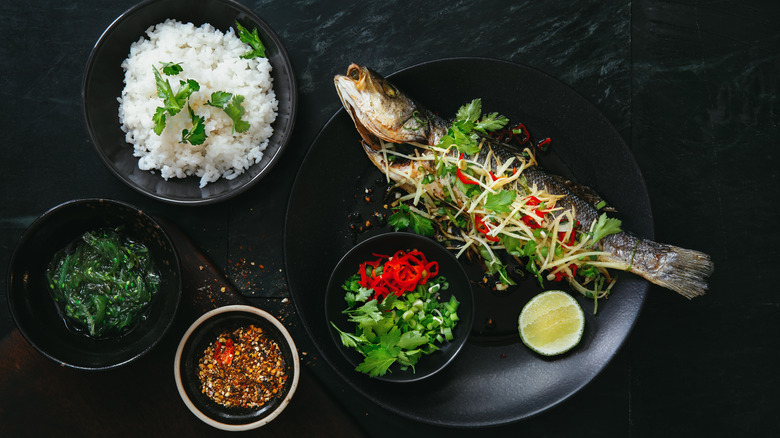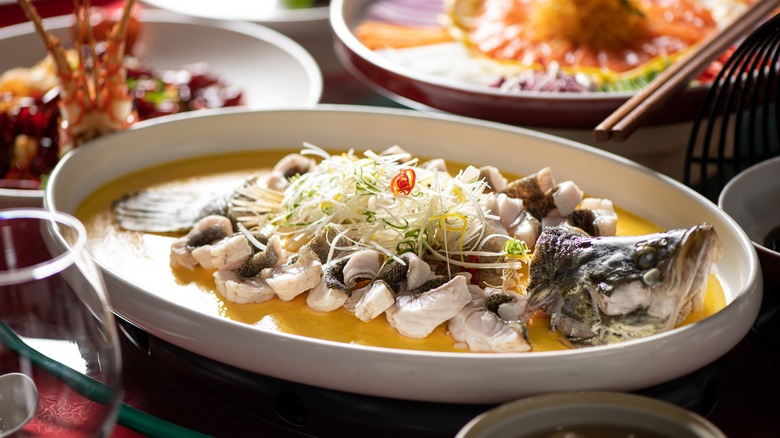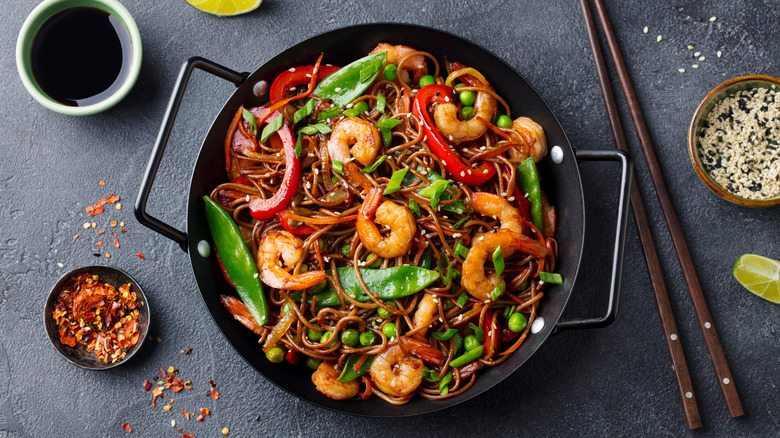How Whole Fish Became A Symbol For Lunar New Year
Few traditions are as widely observed as the Lunar New Year. To put this holiday in perspective, approximately two billion people around the world, or about one-fourth of the total human population, gather around to celebrate the Lunar New Year with loved ones. Food is a major component of this tradition, with dishes like rice cakes and dumplings taking front stage during any dining reunion. Whole fish are among Lunar New Year's culinary staples, and part of the reason why lies in the presence of homophones in the Chinese language.
Because the words 'fish' and 'abundance' share the same pronunciation in Mandarin, many Lunar New Year celebrations began to serve whole fish as a way to manifest incoming wealth in the coming year. Fish aren't the only food items that follow this homophonic connection either — dumplings, for example, sound similar to the phrase 'out with the old, and in with the new' in Chinese. Regardless, the tradition has stuck around for centuries since then, with the head and tail of the fish coming to represent the abundant start and end of the year.
How whole fish are typically eaten during Lunar New Year
With a holiday as widely celebrated as Lunar New Year, it should be no surprise to anyone that people serve whole fish in a variety of ways. Some chefs prefer to bake or even fry an entire carp, but most cooks traditionally steam this fish alongside a pile of aromatics such as scallions and ginger. When the entire fish and other ingredients come together in a steaming basket, it creates a flavorful broth underneath.
The entire fish is then displayed on a large platter alongside some of the accompanying broth, and can then be garnished with fresh herbs, soy sauce, or chili oil. Many people don't finish their whole fish when eating it for the Lunar New Year, as the leftovers are meant to represent remaining wealth for the upcoming months. On the dining table, some families choose to point the heads of the steamed fish toward elders or respected guests as a symbol of reverence as well.
Shrimp and other shellfish are also symbolic seafoods on Lunar New Year
Whole fish is just one of the many seafood recipes for Lunar New Year that hold special meaning to celebrators. Shrimp, for example, symbolize both joy and luck and are typically found in seafood trays and dumpling fillings during this holiday. They are also typically stir-fried with salt and pepper and accompanied with rice or noodles.
Mollusks are also commonly eaten during the Lunar New Year, and take on a plethora of meanings depending on the exact variety. In Cantonese, the word for dried oysters is considered a homophone to 'good business,' and this mollusk also represents luck alongside abalone and shiitake mushrooms. These oysters can be eaten raw or cooked by frying or baking. Clams, on the other hand, visually represent the opening of new opportunities.
Not all seafood represents fortune during the Lunar New Year. In Cantonese, crabs sound phonetically similar to the (all-too-relatable) frustrated sigh – while "stir-fried squid" is a common idiom that means getting fired. These dishes are therefore typically avoided during celebrations and eaten outside of the holiday season.



